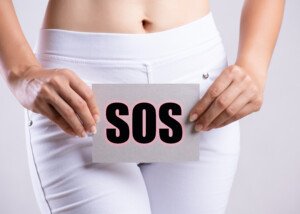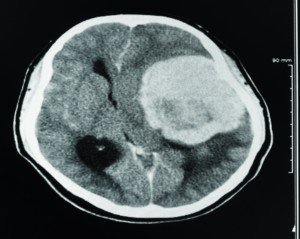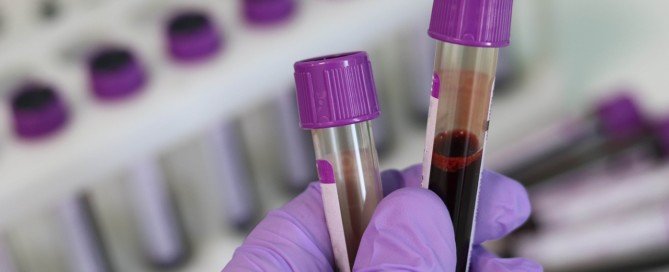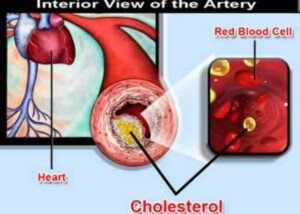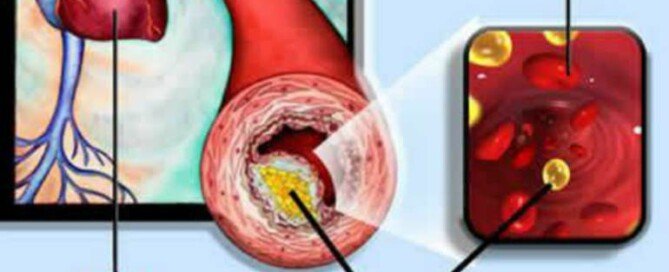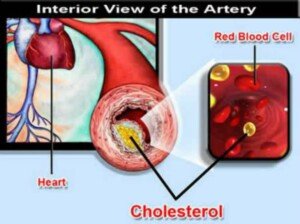Two Menstrual Periods Back to Back, Right in a Row

Ever had one menstrual period right after the other—so just as one period ends, the next one begins?
This phenomenon is characterized by about 10 or so consecutive days of bleeding.
The first cycle in this duet is nothing out of the ordinary.
The second period right on top of it is also nothing out of the ordinary.
The only thing really crazy is that these two periods are back to back.
This once happened to me, and I want to assure you that nothing ever came of it. It happened years ago.
I had my typical period, which includes cramping a few days before real flowing. Prior to real flowing was spotting.
Often, I’d feel cramps for at least two days, occasionally on the third day.
So for this first of the two cycles, I had cramps the first three days and the flowing peaked. Then the bleeding began tapering off.
Just when I thought that this period was over, I began feeling cramps.
Cramps at the end of a period had never before occurred, and I thought this was really strange.
Why was I having cramps at the end – like day 6 or 7, which normally just consisted of brownish-red spotting (residual blood)?
The spotting then began morphing into a pinkish tan, resembling the spotting at the front-end of a menstrual cycle.
And each day after the first period apparently ended, I continued to spot…more and more, until it dawned on me: I’m having another period!
The cramping kicked up and so did the bleeding. The flowing was now like a normal period, and I had to replace my panty liners with maxi pads.
A second period…two smack in a row, back to back! How odd was THAT?
This incident of back to back periods happened only once in my entire life. I’m now postmenopausal.
Back to Back Periods vs. Prolonged Menstrual Bleeding
These two issues are not to be confused. Two periods in a row without any “rest” in between is not the same event as is a single period in which the bleeding is prolonged.
In my case, the first period began with the typical spotting and then escalating amount of blood, peaking on the first and second day.
Then the flow began dwindling on day 3, getting less and less by day 5. And of course, the cramping tapered off early on.
But then things started kicking up again, and the backend spotting morphed to the appearance of frontend spotting, which escalated to full-blown bleeding in the same timeline as any of my typical menstrual cycles.
So there were clearly two cycles here.
Causes of Prolonged Bleeding in a Single Menstrual Cycle
Prolonged bleeding of a single period is a different issue.
“There are multiple possible causes for prolonged bleeding with menses,” says Lindsay Appel, MD, an OB-GYN with the Family Childbirth & Children’s Center at Mercy Medical Center in Baltimore.
“Sometimes, hormonal imbalances can cause anovulation which can lead to irregular episodes of bleeding. In addition, thyroid abnormalities can also impact the menstrual cycle.
“Structural abnormalities of the uterus and endometrium (the lining of the uterus) can also contribute to prolonged bleeding.
“These include uterine fibroids, endometrial polyps or endometrial hyperplasia which is an overgrowth of the endometrium and can lead to endometrial cancer.”
If you can’t tell if you’ve had a prolonged cycle vs. two back to back periods, make an appointment with your gynecologist.
 Dr. Appel addresses a full range of obstetric and gynecologic needs for women. She has participated in several OBGYN research presentations at professional conferences.
Dr. Appel addresses a full range of obstetric and gynecologic needs for women. She has participated in several OBGYN research presentations at professional conferences.
 Lorra Garrick has been covering medical, fitness and cybersecurity topics for many years, having written thousands of articles for print magazines and websites, including as a ghostwriter. She’s also a former ACE-certified personal trainer.
Lorra Garrick has been covering medical, fitness and cybersecurity topics for many years, having written thousands of articles for print magazines and websites, including as a ghostwriter. She’s also a former ACE-certified personal trainer.
Dense Breasts: What an Automated Breast Ultrasound Feels Like

The automated breast screening ultrasound is the latest technology that women with dense breasts should have.
Perhaps the biggest advantage to this technology is that it pretty much eliminates operator error. (more…)
Can a CT Scan Detect a Brain Tumor?
If you had a non-contrast CT scan of your head for whatever reason, such as you fell on your head and feel sick, would it necessarily show a brain tumor if you had one?
“The test of choice to evaluate for brain tumor is the MRI with and without the contrast,” says neurosurgeon Charles Park, MD, Director of The Minimally Invasive Brain and Spine Center at Mercy Medical Center in Baltimore.
“CT’s are usually better to assess the bone related problems and MRI is better for the soft tissue,” says Dr. Park.
However, the CT scan can be used as part of a diagnostic assessment if a brain tumor is suspected.
According to hopkinsmedicine.org, a CT scan “can be helpful in diagnosing some types of brain tumors,” particularly “those near or involving bone.”
The CAT scan can also show bleeding, swelling, bone and tissue calcification that would be caused by a cancer.
If a person has a seizure or exhibits some other alarming sudden symptom such as cognitive impairment, a family member is apt to get that person to the emergency room.
A CT scan will be ordered to find out what’s going on. It will generate an image much faster than will an MRI. Its speed makes it the head scan of choice in emergency situations.
Contrast Dye with the CT Scan?
Dr. Park says, “Using contrast for CT usually is better, since brain tumor will usually enhance or gets brighter on contrast CT.
“Non-contrast may hint at an abnormality but not as conclusive as enhanced CT or MRI.”
The MRI is the gold standard for diagnosing most brain tumors. A contrast dye is used.
The cancerous mass usually “soaks up more dye than normal brain tissue,” says hopkinsmedicine.org.
This will clearly show up on the scan. However, there’s the occasional cancer mass that will not absorb more dye than the surrounding tissue.
CT scans without any contrast are terrific for showing bleeding in the brain from head trauma, but not the mass of a tumor.
Dr. Park specializes in minimally invasive surgical techniques for treatment of conditions affecting the brain and spine. He’s skilled in advanced procedures and techniques that utilize innovative computer technology and image-guided surgery systems.
 Lorra Garrick has been covering medical, fitness and cybersecurity topics for many years, having written thousands of articles for print magazines and websites, including as a ghostwriter. She’s also a former ACE-certified personal trainer.
Lorra Garrick has been covering medical, fitness and cybersecurity topics for many years, having written thousands of articles for print magazines and websites, including as a ghostwriter. She’s also a former ACE-certified personal trainer.
.
Top image: Shutterstock/Richman Photo
Source: hopkinsmedicine.org/neurology_neurosurgery/centers_clinics/brain_tumor/diagnosis/how-to-diagnose-brain-tumors.html
Can a Blood Test Detect a Brain Tumor?
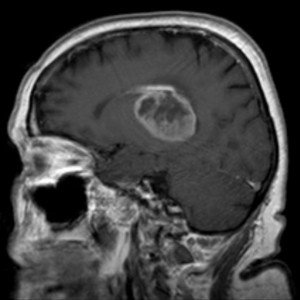
“Depending on the tumors, some blood tests can be used to detect a brain tumor,” says neurosurgeon Charles Park, MD.
“But most of the cases, we find the brain tumor and then do the blood test to see what kind of tumor it is,” says Dr. Park, Director of The Minimally Invasive Brain and Spine Center at Mercy Medical Center in Baltimore.
“For example, if someone has a pituitary tumor, we will do the blood test to see if that tumor is active and producing a certain kind of hormone.
“If it produces prolactin, then we can use medicine to shrink the tumor without surgery.”
How close are researchers to developing a blood test that detects the presence of a brain tumor?
Microvesicles are cell particles that are shed by cancer cells and end up in the bloodstream. They are small enough to cross the blood-brain barrier.
If these can be picked up by a blood test, they potentially can diagnose a brain tumor.
The most common primary brain tumor is a glioblastoma multiforme. By the time this is diagnosed, a patient will usually be dead within 15 months.
The only way currently to diagnose and also monitor a GBM is via imaging tests and biopsies. This is anything but efficacious.
But a simple blood test to do these tasks would change medicine.
Enter Nanotechnology
This groundbreaking technology can be used to magnetically (nuclear magnetic resonance) label the microvesicles.
Researchers are now able to, using a handheld nuclear magnetic resonance instrument, reliably detect microvesicles from tumors in blood samples.
The blood samples with the reliable detection came from both mice and humans with the GMB brain tumor.
The report, published in Nature Medicine (2012), says that this blood test for the brain tumor can be done in a doctor’s office.
So why isn’t this a standard test in doctors’ offices? Well, like any research, this technology must go through a series of phases before it becomes commercialized
Another Possible Blood Test for Detecting a Brain Tumor
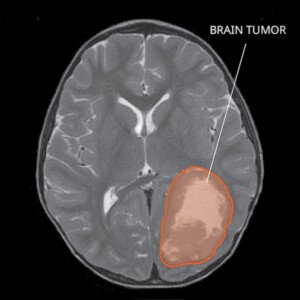
In another study, “nearly all forms of cancer were identified,” says cancer researcher Jonas Nilsson in the report, “which proves that blood-based biopsies have an immense potential to improve early detection.”
The study that he’s referring to, which had a 96% detection accuracy rate, comes from Umeå University in Sweden and was published in Cancer Cell (2015).
The test was done on 228 people with cancer. That was just the detection of a cancer.
As for the origin of the malignancy, there was a 71 percent success, and this origin pertained to the lung, colon, breast, pancreas, liver, rectum, and the brain.
Dr. Park specializes in minimally invasive surgical techniques for treatment of conditions affecting the brain and spine. He’s skilled in advanced procedures and techniques that utilize innovative computer technology and image-guided surgery systems.
 Lorra Garrick has been covering medical, fitness and cybersecurity topics for many years, having written thousands of articles for print magazines and websites, including as a ghostwriter. She’s also a former ACE-certified personal trainer.
Lorra Garrick has been covering medical, fitness and cybersecurity topics for many years, having written thousands of articles for print magazines and websites, including as a ghostwriter. She’s also a former ACE-certified personal trainer.
.
Top image: Hellerhoff
Source: sciencedaily.com/releases/2015/11/151112123708.htm
Cause of Two Periods 14 Days Apart Happening Only Once

The cause of a period coming exactly two weeks after the one before that, and never happening again, may very well be from desire and will.
A subconscious instruction to start menstruating 14 days after the previous period? Yes, it’s possible.
But it’s also possible for the instruction to be conscious or more deliberate.
“Menstrual bleeding that comes two weeks after the previous period is likely due to anovulation or lack of releasing an egg,” Dr. Kimberly Langdon, MD, medical advisor at Medzino.
“Lack of ovulation may be due to stress, and that certainly can be the case prior to one’s wedding [or vacation],” adds Dr. Langdon.
Vacation to Be Ruined by Period
Some years ago I had planned a trip to Hawaii. The days I’d be there fell smack on the days I was expecting my next period. I was infuriated.
This was a big thorn in my side in the weeks leading up to the vacation.
According to the first day of my previous period, my next cycle would begin a few days after I arrived in Hawaii! I was fuming!
14 Days Between Two Periods
However, two weeks after the preceding menstrual cycle began, I started another period; the interval was only 14 days.
This meant that the last day of this next menstruation was the first day of my 10-day vacation!
I just felt SO elated, sitting on that plane as it flew over the ocean, knowing that THIS day was the LAST day of my cycle!
I just couldn’t believe it worked out this way – a 14 day interval! It was a gift!
Never before had I had a two week interval (my next-shortest interval had been 19 days, and these were only a few or so), and no 14-day interval ever occurred again.
I have to believe there was a psychological component to this. Could my internal griping about the projected date of my next cycle have actually “instructed” my cycle to come much sooner to spare me the inconvenience during my vacation?
There is no way that this was a coincidence.
In all the years that I had been menstruating, what are the odds that the ONLY time I have two periods 14 days apart coincides perfectly with a much-anticipated trip to Hawaii?
Is “willing” menstruation to begin sooner a dependable method?
Dr. Langdon says it is not.
“There are medical ways to cause a period to come early or to delay one for a week or two,” says Dr. Langdon.
“Birth control pills can be used to delay a period by skipping the placebo pills and starting the next pill pack during the week that the period is expected.
“The mind is a powerful tool for change, so it’s not out of the realm of possibility that one could ‘will’ an early period — especially if anxiety is severe enough.
“Anxiety is stressful, and stress affects our menstrual cycles among other bodily processes.”
Because I am now postmenopausal, I can say with 100 percent accuracy that the 14 day interval between two periods was a one-time event.
 Dr. Langdon, who is now retired from clinical practice, has delivered over 2,000 babies. Besides obstetrics, she specialized in gynecologic situations such as menstrual disorders, vaginitis, menopause, contraception, pelvic pain and minimally-invasive surgeries.
Dr. Langdon, who is now retired from clinical practice, has delivered over 2,000 babies. Besides obstetrics, she specialized in gynecologic situations such as menstrual disorders, vaginitis, menopause, contraception, pelvic pain and minimally-invasive surgeries.
 Lorra Garrick has been covering medical, fitness and cybersecurity topics for many years, having written thousands of articles for print magazines and websites, including as a ghostwriter. She’s also a former ACE-certified personal trainer.
Lorra Garrick has been covering medical, fitness and cybersecurity topics for many years, having written thousands of articles for print magazines and websites, including as a ghostwriter. She’s also a former ACE-certified personal trainer.
.
Top image: Shutterstock/Emily frost
Can a 24/7 Headache for Several Months Be a Brain Tumor ?

Your fear of a brain tumor is not imaginary if you’ve been having a 24/7 headache for the past several months.
“The most common symptoms of brain tumors are headaches,” says neurosurgeon Charles Park, MD, Director of The Minimally Invasive Brain and Spine Center at Mercy Medical Center in Baltimore.
Can a headache that goes on 24 hours a day, seven days a week, for several months ongoing, be caused by a brain tumor?
“It is very possible that the headache can be 24/7 and last several months,” says Dr. Park.
Can you dismiss the possibility of a brain tumor if this 24/7 headache is not accompanied by other symptoms suggestive of cancer?
No. You may have heard or read something like, “If it was a brain tumor, you’d have other symptoms.”
However, that needs qualification. If the situation is not treated, you WILL eventually begin developing other symptoms.
But what about, say, three months out from the onset of the new headaches?
Dr. Park says, “At times, there can be new-onset symptoms, such as seizures, weakness and balance problems, depending on the location of the tumors.”
So during that several months, you may NOT have these signs and just have the headaches.
There are benign causes of a 24/7 headache that goes on for weeks and weeks.
One such cause is a pinched or compressed nerve that branches out of the cervical (neck) vertebrae.
A tip-off that the constant daily headache might be from a brain tumor is when the headache is the worst.
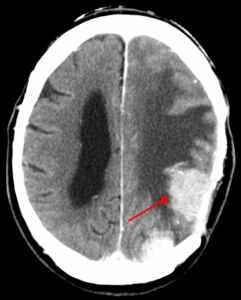
A benign brain tumor, such as a meningioma, can also cause very severe headaches. James Heilman, MD, CreativeCommons
“The classic features of brain tumor related headaches are the morning headaches,” says Dr. Park.
“When we lay down to sleep, the brain tissue, including the tumors, will expand slightly and increase symptoms, such as headaches.”
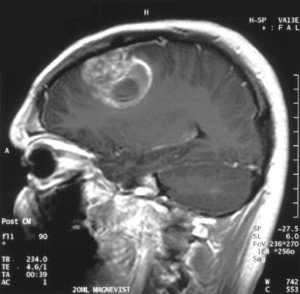
Brain tumor near top of head. Credit: Christaras
Usually, if you’ve had a constant headache every day for many weeks, that is caused by a brain tumor, there will be other symptoms with it.
Additional Symptoms of a Brain Tumor
(no particular order)
• Nausea/vomiting
• Appetite loss
• Unexplained weight loss
• Visual disturbances
• One drooping eyelid
• One eye bulging a little more than the other
• One eye a bit off center
• Hearing loss
• Cognitive changes
• Behavioral changes
• Numbness in part of the face
• Unexplained fatigue
• Speech difficulty
Symptoms may develop gradually. But a headache is often the first symptoms and the only symptom for several weeks – even several months.
It may come and go. The headache may be present only in the morning. If it’s 24/7, the brain tumor headache will very likely be at its worst on most mornings.
Dr. Park specializes in minimally invasive surgical techniques for treatment of conditions affecting the brain and spine. He’s skilled in advanced procedures and techniques that utilize innovative computer technology and image-guided surgery systems.
 Lorra Garrick has been covering medical, fitness and cybersecurity topics for many years, having written thousands of articles for print magazines and websites, including as a ghostwriter. She’s also a former ACE-certified personal trainer.
Lorra Garrick has been covering medical, fitness and cybersecurity topics for many years, having written thousands of articles for print magazines and websites, including as a ghostwriter. She’s also a former ACE-certified personal trainer.
.
Top image: Shutterstock/wavebreakmedia
Periomenopause, Anxiety and Sadness: Treatments

Anxiety really CAN be caused by periomenopause – the precursor to menopause that no woman looks forward to. Here are natural (and surprising) treatments. (more…)
When Menopause Raises “Bad” Cholesterol: Solution
The so-called bad cholesterol can be raised by menopause—and that’s really bad.
But there IS something you can do to knock this cholesterol back down. (more…)
Does Heavy Bleeding During Menopause Mean Cancer?

Heavy bleeding during menopause is NOT normal under any circumstances and could actually mean cancer. Certain cancers can cause heavy bleeding. (more…)
Heavy Bleeding after a Colposcopy: Causes & What to Do





